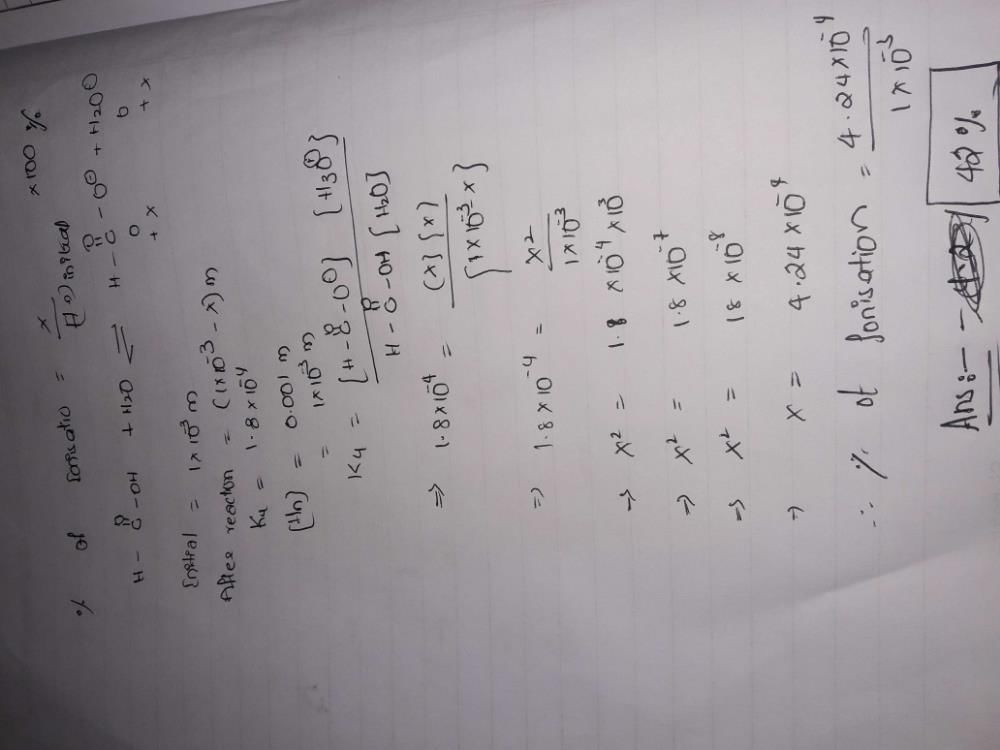NEET Exam > NEET Questions > The ionisation constant of formic acid HCO2H ...
Start Learning for Free
The ionisation constant of formic acid HCO2H is 1.8× 10^-4.what is percentage ionisation of a 0.001M solution of this acid?
Most Upvoted Answer
The ionisation constant of formic acid HCO2H is 1.8× 10^-4.what is per...

Community Answer
The ionisation constant of formic acid HCO2H is 1.8× 10^-4.what is per...
Calculation of Percentage Ionisation of Formic Acid
Giving the Given Data:
- Ionisation constant of formic acid (HCO2H) = 1.8 × 10^-4
- Concentration of formic acid (HCO2H) = 0.001 M
Formula:
Ionisation constant (Ka) of an acid is the ratio of the concentration of the dissociated ions to the concentration of the undissociated acid. Mathematically,
Ka = [H+][A-]/[HA]
where [H+] is the concentration of hydrogen ions, [A-] is the concentration of the conjugate base and [HA] is the concentration of the acid.
The percentage ionisation of an acid can be calculated by the following formula:
Percentage Ionisation = (Concentration of dissociated ions / Concentration of acid) × 100
Solution:
Firstly, we need to calculate the concentration of hydrogen ions (H+) and the concentration of the conjugate base (A-).
Since formic acid (HCO2H) is a weak acid, it dissociates partially in water, giving H+ and HCO2- ions.
Let the concentration of H+ be x.
Then, the concentration of HCO2- will also be x.
The concentration of undissociated formic acid (HA) will be (0.001 - x).
Therefore, the ionisation constant (Ka) can be calculated as:
Ka = [H+][A-]/[HA]
1.8 × 10^-4 = x × x / (0.001 - x)
On solving the above equation, we get x = 0.0085 M
Now, we can calculate the percentage ionisation of formic acid as:
Percentage Ionisation = (Concentration of dissociated ions / Concentration of acid) × 100
Percentage Ionisation = (0.0085 / 0.001) × 100 = 0.85%
Conclusion:
The percentage ionisation of a 0.001M solution of formic acid (HCO2H) is 0.85%.
Attention NEET Students!
To make sure you are not studying endlessly, EduRev has designed NEET study material, with Structured Courses, Videos, & Test Series. Plus get personalized analysis, doubt solving and improvement plans to achieve a great score in NEET.

|
Explore Courses for NEET exam
|

|
Similar NEET Doubts
The ionisation constant of formic acid HCO2H is 1.8× 10^-4.what is percentage ionisation of a 0.001M solution of this acid?
Question Description
The ionisation constant of formic acid HCO2H is 1.8× 10^-4.what is percentage ionisation of a 0.001M solution of this acid? for NEET 2024 is part of NEET preparation. The Question and answers have been prepared according to the NEET exam syllabus. Information about The ionisation constant of formic acid HCO2H is 1.8× 10^-4.what is percentage ionisation of a 0.001M solution of this acid? covers all topics & solutions for NEET 2024 Exam. Find important definitions, questions, meanings, examples, exercises and tests below for The ionisation constant of formic acid HCO2H is 1.8× 10^-4.what is percentage ionisation of a 0.001M solution of this acid?.
The ionisation constant of formic acid HCO2H is 1.8× 10^-4.what is percentage ionisation of a 0.001M solution of this acid? for NEET 2024 is part of NEET preparation. The Question and answers have been prepared according to the NEET exam syllabus. Information about The ionisation constant of formic acid HCO2H is 1.8× 10^-4.what is percentage ionisation of a 0.001M solution of this acid? covers all topics & solutions for NEET 2024 Exam. Find important definitions, questions, meanings, examples, exercises and tests below for The ionisation constant of formic acid HCO2H is 1.8× 10^-4.what is percentage ionisation of a 0.001M solution of this acid?.
Solutions for The ionisation constant of formic acid HCO2H is 1.8× 10^-4.what is percentage ionisation of a 0.001M solution of this acid? in English & in Hindi are available as part of our courses for NEET.
Download more important topics, notes, lectures and mock test series for NEET Exam by signing up for free.
Here you can find the meaning of The ionisation constant of formic acid HCO2H is 1.8× 10^-4.what is percentage ionisation of a 0.001M solution of this acid? defined & explained in the simplest way possible. Besides giving the explanation of
The ionisation constant of formic acid HCO2H is 1.8× 10^-4.what is percentage ionisation of a 0.001M solution of this acid?, a detailed solution for The ionisation constant of formic acid HCO2H is 1.8× 10^-4.what is percentage ionisation of a 0.001M solution of this acid? has been provided alongside types of The ionisation constant of formic acid HCO2H is 1.8× 10^-4.what is percentage ionisation of a 0.001M solution of this acid? theory, EduRev gives you an
ample number of questions to practice The ionisation constant of formic acid HCO2H is 1.8× 10^-4.what is percentage ionisation of a 0.001M solution of this acid? tests, examples and also practice NEET tests.

|
Explore Courses for NEET exam
|

|
Suggested Free Tests
Signup for Free!
Signup to see your scores go up within 7 days! Learn & Practice with 1000+ FREE Notes, Videos & Tests.

























